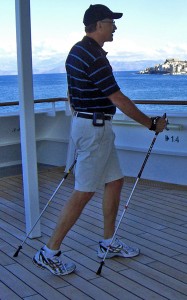The first thing to do is to get familiar with your poles. Good ones are assembled in Europe with minimal Asian components. They are very lightweight – about eight ounces each. Better poles have quick release straps to allow you to remove your hands quickly. You don’t want to whack anyone while you are answering your cell phone. Rubber tips can be installed for quiet walking or on sensitive surfaces, such as the deck of a ship or tile flooring. The carbide steel tip is used on grass, trails and gravel surfaces. They can also work on sidewalks or streets, but are very noisy.
While fixed length poles are often used by advanced people, the common person is very happy with adjustable poles. Those can come in two sections (best for classes) or three sections (packable for travel). Fixed length poles are almost impossible to carry in most suitcases. The adjustable poles are more convenient. TSA will not allow poles in carry-on. Most poles have twist lock connections to hold the poles at the length you want. Here’s how to use them:
1. Set the length. Put the tip by your little toe, elbow at your side, hand in front. Adjust the length so your elbow is about at 90 degree angle.
2. Place your hands in grips. Left or right. See L or R on the straps. While the poles are identical, the straps are made for each hand. Some brands only have a universal strap. I like to put a piece of red tape on the right pole to make it easier to locate.
 3. Put your hands in the grips facing forward, then put the rubber tips on so they are flat on the surface as shown.
3. Put your hands in the grips facing forward, then put the rubber tips on so they are flat on the surface as shown.
4. Walk normally alternate left/right legs with right/left arms – naturally. Keep you head up – don’t look at the poles; they will come along.
5. Keep the poles behind you – drag them. Don’t pick them up and don’t put in front. You will not get the maximum benefits if you do.
6. When the pole is at your side, push it slightly into the surface. The pole tips remain behind to push off. Thinkof the poles as if they are propelling you forward. Feel your triceps tighten with each push.
 7. Keep your head up, shoulders back. Don’t look at the poles. Look far ahead.
7. Keep your head up, shoulders back. Don’t look at the poles. Look far ahead.
One exercise I love to have my students do is the “heart rate challenge.” Put your poles down. Take your resting heart rate. Now walk without the poles for about 30 yards and come back. Take your pulse again. Record or remember it. Surely it went up. Now cool down and take 5. OK, now strap on your poles and walk the same distance at the same pace – nothing extra. Come back to the starting point and check your pulse. WAY higher isn’t it? And with no extra effort over your walking measurement!
Try to get into your aerobic zone – 60-80% of your maximum. How do you find that? Well, there is a formula (220 – age) but here’s a table you can use to look up your zone. Your heart will be getting the most out of cardio exercise while you are in the aerobic zone. Another thing: If you exercise less than 20-minutes, your body tends to burn carbohydrates. Go 30-minutes or more and it will use fats for energy. Burn more calories!
There are more advanced techniques, such as the “grip and go,” the “swagger,” the “hop-skip,” the “zig-zag,” Nordic jogging and Nordic skating, etc. Take my class and I’ll show you these and more.
Note: Some people have trouble with their “reciprocal gait.” This is the normal left/right leg step while your arms are right/left. Humans normally walk this way. NOT with the same side leg/arm together. I call that the “robot.” To get you moving correctly, pretend you are in the military and you respond to “forward march” with your right foot forward (that’s standard). At the same time “shake a hand” – with your right hand. Keep going and keep the rhythm. You can even whisper “left, right, left, right” to get your pace down. That’s what soldiers do!
With Nordic Walking the poles are not clutched in a “death grip.” Rather, they are only pulled forward by the strap to begin each stride. The technique is to plant the poles behind you and do a mini-push off with each step. It is the involvement of the triceps, lats and core muscles in this resistance maneuver that leads to the many benefits. These little push-offs make the difference. The poles are not lifted and placed in front of you. They remain behind you and out of sight.
A good routine is to do 30-minutes of Nordic Walking 3-days a week, building up to longer sessions. Remember that the body begins to burn fat after about 20-minutes so this is a bonus for weight control. Keep your heart rate at about 80% of your maximum, based on your age. One additional benefit of using poles – you carry a level of protection against snakes, dogs and other hostile critters!
Warning: Do not be embarrassed using your poles on city sidewalks. You will probably get cat-calls from neighbors like “Where’s the snow?” Forget them. Be satisfied that you are burning 20% more calories than them. Nordic Walking is fun alone (a good music source can pace you along). In groups or with a friend it’s even better. You will be amazed at how long you can go when you are on “autopilot” and talking.
A common question I get is: “Can I use my ski poles or trekking poles to do Nordic Walking? Well, yes, but could you play basketball with a football? Yes, but you’d only get a couple bounces. Could you ride a mountain bike on a long road trip? Yes, but knobby, low pressure tires and an upright seat would not be optimal. Could you ride a road bike on mountain trails? Yes, but the 130 psi tires, narrow seat and dropped handle bars could spell disaster. But you could do it. Ski and trekking poles are optimized for those activities. Nordic Walking is a different experience and the poles are designed with that in mind.


